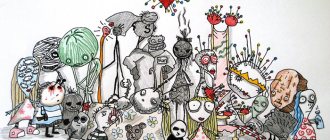Patterns of personality behavior in conflict
Analysis of conflicts and methods of their resolution allowed conflict scientists to identify and describe the most typical models of behavior of subjects within the framework of a conflict.
Thus, in the professional literature there are three main models of individual behavior in conflict:
- constructive,
- destructive,
- conformist.
Each of these models is predetermined by the subject of the conflict, the general characteristics of the conflict situation, the values of the subjects, as well as the individual psychological characteristics of each of them. Behavior patterns also reflect the dynamics of the conflict and possible ways to resolve it.
Note 1
Determining the model is a desirable and necessary step in cases where there is a need to resolve a dispute.
Are you an expert in this subject area? We invite you to become the author of the Directory Working Conditions
Thus, the following main models of individual behavior in conflict are distinguished:
- Constructive. The subject strives to resolve the conflict and is aimed at finding an optimal solution. In addition, he is characterized by restraint, self-control, a friendly attitude towards his opponent, openness, a positive attitude, and conciseness in communication. Tries to highlight only the most important thoughts.
- Destructive. Within the framework of this model of behavior, the person constantly strives to expand and aggravate the conflict, to belittle the partner, negatively evaluates his personality, and shows both suspicion and distrust of the opponent. Communication ethics are often violated.
- Conformist. The subject is passive, prone to concessions, inconsistent in his judgments, as well as in his behavior. He easily agrees with the point of view of his opponent and tries to avoid resolving sensitive issues.
The danger of the latter model is that it not only promotes aggression on the part of the opponent, but also periodically provokes it. This strategy is also destructive, but only with the opposite sign. The conformist model can play a positive role in resolving a conflict when the subject of the conflict is not significant. In this case, this model will allow you to quickly resolve the conflict that has arisen.
Finished works on a similar topic
Course work Models of behavior in conflict depending on the status of the parties and the situation 410 ₽ Abstract Models of behavior in conflict depending on the status of the parties and the situation 250 ₽ Test work Models of behavior in conflict depending on the status of the parties and the situation 210 ₽
Receive completed work or specialist advice on your educational project Find out the cost
Personality as a subject and object of social relations
Life shows that no matter how different and incomprehensible people are to each other, they will
together, if the subject of their attention is the joy of their neighbor and their own ability to rejoice in him. A
therefore, every person should strive for plasticity, flexibility in relationships, to be easy on
transitions from dominance to dependence, from openness to greater autonomy, etc. The easier it will be
these transitions, the less often a person pays attention to them, the less mutual resentment, irritation,
discontent, conflicts. The desire to better understand your loved ones, friends, colleagues, to see in a new way
3 pages, 1113 words
Psychogenetics of human behavior. Behavior patterns
... this or that family, intertwined with life circumstances, develops into a certain pattern of behavior, invariably repeated from generation to generation. A model of behavior is a stable, specific, ... GENOGRAM, we analyze the relationships that have existed and continue to exist in the family. A stable MODEL OF BEHAVIOR or PATTERN can be not only negative, as in the above ...
relationships with them, learning to constructively overcome difficulties of mutual understanding are the main
factors of interaction between people in society.
When talking about an individual, we usually mean an individual, a person or
individuality. These concepts, being the same in meaning, are not completely synonymous, they are not identical.
They define different aspects of a person’s essence.
An individual is a living organism, a biological
being of the human race and in this capacity his birth, inherent in him, is recorded
physiological state and psyche, possibilities of adaptation to the social environment. Individual –
subject of existence, element of the social system of material production and consumption,
which at the same time is formed and developed in the process of activity, assimilation and reproduction
established methods of work and management determined during the historical movement.
Personality expresses a broader set of human qualities than the individual, which
are formed under the influence of both natural properties inherent in all people and social factors.
If a person is born an individual, he becomes a person, to one degree or another overcoming
inconsistency and relative independence of their natural, social and spiritual essences,
showing the ability to understand and transform the surrounding world. Unlike the individual, personality
not a statistician of historical development, but an actively acting subject and object of social relations and
connections.
Individuality is the manifestation of the traits of a specific personality with its originality and uniqueness,
a measure of how an individual differs from others of his own kind. This is a man, as if in a single copy, in all his
originality, including external features, character specificity, intelligence capabilities, etc. So, to
For example, the individual qualities of a person are emphasized when they state: Adam Smith, whose
his name is inscribed in the annals of world history as a classic of political economy, the founder
labor theory of value and a number of other economic doctrines, was the most educated person of his
time, possessing extensive knowledge and impeccable moral authority.
Foreign and domestic psychologists understand the subject as a personality or human
a community that is extremely active and persistent in achieving its goals
goals, create their own destiny, enriching themselves with life experience.
The object of public relations
people act when they are passive, completely subordinate to external circumstances,
being content with the smallest results of their own activities.
Each individual person is a social being, possessing self-awareness, actively
active, i.e. capable of work, creativity, and purposeful change in the surrounding world. Before
23 pages, 11283 words
Development of a young person’s personality through intellectual and creative games
... conditions for enhancing the cognitive activity of adolescents with deviant behavior" (M., 1996) S.V. Kalinina identifies the following requirements for activating... CREATIVE GAMES AS A MEANS OF DEVELOPMENT AND CORRECTION OF THE PERSONALITY OF ADOLESCENTS AND YOUTH. Despite the rather extensive... attempts at theoretical analysis of this phenomenon are being carried out by people far from practice, and practical developments are not...
In all, what is important is a person’s inherent ability to work and other activities that include a goal,
the means, the result and the process of expedient action. Every person is a representative
state, nation, class or layer and acts respectively as a citizen, representative of the nation,
worker, peasant or intellectual. It is in deeds, creation, creativity that a person not only
discovers and manifests himself, but in them he is formed and develops as a personality.
Possessing social certainty, the individual is included in one or another type of social
relationships as a bearer of specific qualities of the corresponding communities. Outside public
relations there is no personality, and outside of social-class relations there is no political personality. Personality
lives in time and can evaluate itself by comparing it with itself in the past or in the desired future. Many
psychologists believe that self-esteem is not enough for self-esteem. Each self-assessment indicates the severity of
as much of a given quality in a person as of the degree of his deviation from some standard, point
reference in assessment. (1)
Personality is a multidimensional phenomenon. “There are hours,” wrote George Sand, “when I escape from the very
myself when I feel like grass, a bird, the top of a tree, a cloud, running water, the horizon,
color, shape and sensations, transient, indefinite;... I live in what constitutes the environment
development, which is, as it were, an extension of my own being.” (2) Scientists often ask themselves
question: “Where are the primary sources of self-knowledge, where is the Self born, which is destined to see itself kinder
how…?" From a materialistic point of view, the determining role of relationships with other people in the development of
personality was first conceptualized by Ludwig Feuerbach. “The individual,” he wrote, “is like something
the isolated does not contain human essence either as a moral being or as a
thinking
The human essence is present only in communication, in the unity of man with man, in
a unity based only on the reality of the difference between I and Thou.” (3) These ideas became some of the
key in Marxism: “... a person first looks, as in a mirror, into another person.” (4)
People are born free and equal in their human dignity and rights, nevertheless
the realities are not the same. From the unconditional recognition of the fact of the diversity of people it follows
the conclusion that there is no person consisting only of merits, without any flaw or
weaknesses. In order to better understand people, be conscious of conflicts and understand those
the reasons by which they are caused, you need to know complete information about the person with whom you are communicating and
interact. It is impossible not to take into account the fact that the behavior of any person, his actions and deeds
determine the individual’s reaction to a particular life situation.
Psychologists call the main qualities of a person - intellectual, strong-willed and
emotional. Intellectual qualities include such properties as thinking, combination
6 pages, 2524 words
Psychological characteristics of a person. Character and temperament 3-4
...the fault of the victims themselves. Therefore, the study of such mental qualities of a person as emotionality, temperament, will, character, intelligence and morality will allow us to study the mental state in... self-control is weakened, which can lead to injury. A change in a person’s mental state is possible from prolonged use of alcohol, medications containing narcotic substances, ...
a person’s knowledge, his desire for truth, as well as his views, principles and life position. Strong-willed
qualities are associated, first of all, with motives that encourage action, manifestation of abilities
a person, his disposition towards other people. Emotional qualities absorb the most
various nervous arousals, experiences and feelings associated with such moral values,
like goodness, duty, honor, friendship, love, etc. Emotions taken together can effectively signal
actualization of vital forces, about the individual’s readiness to bring benefits to people, to be responsible to society and
yourself for your actions.
Among the most important properties of a person, which accumulate his qualities with their special social
justice, responsibility and legal awareness stand out as important. All these personality traits, without
doubts influence the emergence of conflicts, their subsequent development and resolution. Specialists
focus on one more property of a person - reflection, i.e. self-analysis by each of their knowledge
and actions, thinking about their boundaries and meaning, how they are perceived and evaluated
other people.
A number of human qualities inherent in him genetically deserve special attention. First of all,
there is an indirect relationship between conflict and temperament - those stable
properties of an individual that characterize the dynamic features of the psyche of a given person, including
since the time of Hippocrates to sanguine, phlegmatic, choleric or melancholic people. It is known that
a sanguine person is active and quick, gets along with people easily, is cheerful and active, but cannot tolerate
monotony and monotonous work. The phlegmatic person is more restrained in behavior and patient, controls himself, but
as a rule, little active. Choleric people can be quick-tempered and overly straightforward, often demonstrating
high performance, his activity and energy alone either go over the edge or experience temporary
decline A melancholic person is impressionable, emotional and responsive, but often shows indecision and
slowness, does not adapt well to new conditions, experiences failures painfully, easily falls into
despondency. The influence of individual make-up, clearly expressed mental properties of a person on his
conflict appears to be more noticeable. Temperament has a significant impact on behavior
person in interpersonal conflicts. For example, a choleric person can easily be drawn into a conflict situation, and
A phlegmatic person, on the contrary, is difficult to anger.
An important role in the emergence and development of conflict is played by personality traits, its basic
characteristics. There are two main psychological axes of personality: extraversion - introversion;
emotional instability – emotional stability. Extroverts are people who demand
constant stimulation, “feeding” from the external environment. They are sociable and eager to try new things.
impressed, prone to risk, love change. Introverts derive incentives for vital activity from
from the inside, they live mainly by their inner world. They are reserved, love order, are friends with few people,
but faithfully. Emotionally unstable people are characterized by constant emotional
11 pages, 5086 words
Test “description of behavior in conflict by K. Thomas” 3 Diagnostic methodology ...
... Results of a study of the relationship between behavior in conflict and individual typological characteristics of a person 3.1 Results of the Eysenck questionnaire 3.2 Results of the test “description of behavior in conflict by K. Thomas” 3.3 ... (12) Interpersonal conflict reveals a lack of agreement in the existing system of interaction between people. They have opposing opinions, interests, points of view, views...
tension, the experience of personal threat, increased sensitivity to failures and mistakes.
Emotionally stable people - they are characterized by emotional balance, inability
deeply empathize with other people's experiences. This typology of character traits was given by Karl
Jung (1875-1961) in the book “Psychological Types” (1921), which is still considered one of
the most convincing and is widely used in both theoretical and practical psychology.
According to the views of A. Adler, the formation of personality character occurs in the first five years of life
person. During this period, he experiences the influence of unfavorable factors, which give rise to
he has an inferiority complex. Subsequently, this complex has a significant impact on
a person’s behavior, activity, way of thinking, etc.
This typology convincingly shows that people’s characters are different (at least there is
16 types of characters).
Misunderstandings due to mismatched character types begin when
only their own preferences are uncompromisingly defended. The better people know the traits
their character, the more fruitful their interaction with other people will be. The essence of Eric's theory
Erikson (1902-1994) is that he put forward and substantiated the idea of the stages of psychosocial
personal development, each of which each person experiences his own crisis. But on every
At the age stage, either a favorable overcoming of a crisis situation occurs, or an unfavorable one.
The level of personal development is another important factor influencing the emergence of interpersonal
conflict. Personality develops and improves in the process of its socialization, active assimilation and
reproduction of social experience. A person has to adjust his actions in accordance with
generally accepted norms and rules of behavior of others. For this manifestation of one’s temperament and
character must be kept under constant control.
The concept of socialization is one of the central concepts of such academic disciplines as
sociology, psychology, political science and others. Although each of these disciplines invests in
the concept of socialization has its own meaning; in general, socialization is understood as the totality of all social
processes through which an individual acquires social experience as a result of communication and activity
acquires certain norms and values that allow him to function as a member
society.
Strategies for dealing with conflict
The issue of behavior strategy in conflict is considered by various scientists, not only conflictologists, but also psychologists. In particular, such scientists as A.Ya. Yantsupov, S.V. Baklanovsky are focused on studying the attitude of an individual or a group of people in relation to the conflict, thus determining the form of people’s behavior.
R. Kilman and K. Thomas developed a two-dimensional and three-dimensional model of the strategy of individual behavior in conflict. Its essence lies in the fact that each participant in the conflict evaluates and correlates his interests with the interests of other people, finding out what he will gain in the event of a positive or negative resolution of the conflict, what losses he will suffer. Based on the current situation, the opponent consciously chooses a strategy for his behavior, which can exist in the following options:
- care;
- compulsion;
- compromise;
- concession;
- cooperation.
In addition, according to psychologists, analysis of the interests of another person often occurs unconsciously, especially when the conflict is spontaneous and the situation is characterized by powerful emotional tension. Individuals evaluate their interests in a conflict by choosing the appropriate model of behavior, which can be correlated with quantitative parameters. However, maintaining your own interests or the interests of your opponent depends on three main circumstances:
- content of the subject of the conflict;
- presence of interpersonal relationship values;
- personality characteristics, including individual psychological ones.
A special place in the conflict is occupied by the value of interpersonal relationships between the subject and his opposing side. If the relations between the subjects do not represent any value, that is, relations of friendship, love, camaraderie or partnership are not established between them, then such a conflict will be destructive, and it is also possible to use strategies such as coercion, struggle or rivalry. On the contrary, if interpersonal relationships are important to the subject, then compromise, cooperation, withdrawal or concession may occur.
Figure 1. Behavior strategies in conflict. Author24 - online exchange of student work
Socially destructive behavior
Socially destructive behavior is associated with social maladaptation - a lack of understanding of the rules by which human society exists and functions. A person who demonstrates destructive and antisocial behavior is unable to find himself in society. Thus, the destructive nature of his behavior only intensifies. Socially destructive patterns of his behavior can be expressed as follows:
- Social and personal discredit . Undermining the reputation or authority of an individual. Tendency to criticize and condemn. Openly offensive and disrespectful behavior.
- Competition . Destructive behavior can be caused by fear for one’s position in a team, which leads a person to attempts to assert himself through other members of this team.
- Avoiding sincere communication . A person exhibiting destructive behavior patterns avoids open communication. It is unlikely that he will be able to adequately answer the direct question “why are you behaving this way?”
Read the article: Destructive relationships - how to improve interpersonal relationships in the family?
Characteristics of the main strategies of people's behavior in conflict
The characteristics of the main strategies of people’s behavior in conflict can be represented in the form of a three-dimensional model:
- Coercion - includes struggle, competition, confrontation. Subjects interact with each other, causing each other mutual damage. One's own interests are assessed as high, and the opponent's interests as low. The choice of strategy ultimately comes down to the fact that it is necessary to choose either interest or the establishment of friendly relationships. At this stage, destructive models of behavior are formed, as subjects actively use power, the force of law, connections, authority, etc. However, the use of this strategy in many cases is ineffective, with the exception of two cases: when protecting oneself from an attack or when protecting one’s interests from a conflicting person.
- Withdrawal is a strategy of behavior in conflict, which is characterized by the opponent’s desire to avoid resolving the problem that has arisen, that is, it implies avoidance of the conflict. It is characterized by a low level of opponent responsibility
- Concession is a type of behavior strategy in a conflict, which is characterized by the desire of one subject to escape from the conflict, to concede in the realization of any interests. It is necessary to be able to analyze the reason for leaving. More often than not, personal interests are low here, but the opponent’s interest is highly valued. In other words, the subject who has chosen this strategy highly values the opponent’s interest and sacrifices his own interests.
- Compromise is a type of behavior strategy for a subject in a conflict that is focused on mutual cooperation. A compromise is characterized by the presence of a balance of interests of the parties. The compromise strategy allows you not to spoil interpersonal relationships, especially if they are important for the subject.
- Cooperation is a type of behavior in conflict, which is characterized by the presence of mutual efforts on the part of the parties, which are aimed at resolving the problem that has arisen. Here, not only one’s own interests are realized, but also interest in the goals and motives of the opponent’s behavior is shown, and interpersonal relationships are established. In some cases, cooperation is excluded when the subject of the conflict has vital interests for the subject; in addition, cooperation is one of the most complex strategies and can include all of the above types of strategies.
Get paid for your student work
Coursework, abstracts or other works
Types of destructive behavior
Classification of destructive behavior is difficult, since specialists have to work with a floating value - the norm. It is subject to change, and what is considered acceptable today will be beyond the scope of adequate behavior tomorrow, and vice versa. Basically, psychologists divide destructive behavior into two large groups:
- delinquent behavior (exceeding legal boundaries, breaking the law);
- deviant behavior (non-compliance with generally accepted standards of morality and morality).
Since the first third of the 20th century, many scientists, psychologists and sociologists have been thinking about what kind of behavior can be placed within the framework of deviations and destructive behavior, and whether such behavior always carries exclusively negative consequences. Many classifications have been developed. Here is a table showing different approaches to understanding destructive behavior.
| date | Scientist | Classification | The essence |
| 1938 | R. K. Merton | Subordination | Acceptance of public goals and means of achieving them |
| Innovation | Acceptance of social goals, but not the means to achieve them | ||
| Ritualism | Denial of a goal due to the inability to achieve it, but maintaining the desire to achieve it | ||
| Retreatism | Leaving society due to disagreement with its goals and means of achieving them | ||
| Mutiny | An attempt to change social goals and means of achieving them | ||
| 1981 | V. V. Kovalev | Deviations of a socio-psychological nature | — violation of discipline; — violation of social norms; — violation of legal norms; - demonstration of self-destruction. |
| Deviations of a pathological nature | - pathological; - non-pathological. | ||
| Personal-dynamic deviations | - reaction; - development; - state. | ||
| 1987 | F. Pataki | Predeviant syndrome (preconditions for deviant behavior) | — affective type of behavior; - conflicts in the family; — aggressive actions; - desire for antisocial behavior in childhood; — intolerance to the educational process; - low level of intellectual development. |
| Basics of deviant behavior (stable forms) | - crime, - alcohol addiction, - drug addiction, - suicide. | ||
| 1990 | Ts.P.Korolenko | Non-standard actions | Motivated destructive behavior that goes beyond generally accepted norms. |
| Destructive behavior | — behavior aimed at violating social attitudes; - escape from reality with the help of psychotropic substances; — violation of rights and laws; - self-destruction (conformism, narcissism, fanaticism, autism, suicide). | ||
| 1995 | V. N. Ivanov | Pre-criminogenic behavior | Ignoring the rules of behavior in public places, minor offenses, drug use. |
| Criminal behavior | Criminal offenses | ||
| 2001 | Yu.A. Clayburgh | Negative behavior | Self-destruction |
| Positive behavior | Creation | ||
| Neutral behavior | Begging | ||
| 2004 | E.V.Zmanovskaya | Antisocial behavior | Violation of legal norms, laws, criminal liability. |
| Antisocial behavior | Violation of ethical standards leading to difficulties in interpersonal communication. | ||
| Self-destructive behavior | Behavior in one way or another entails harm to oneself. | ||
| 2010 | N. V. Maysak | Deviations by nature of behavior | — constructive behavior (creativity); — self-destructive (addictions and suicidal tendencies); — externally destructive (legal violations, communication deviations). |
| Deviations by level of acceptance by society | - approved (adaptation to the group); — demonstration of neutrality (ambiguity in assessing behavior); — disapproved (deviation from ethical and legal norms). |









